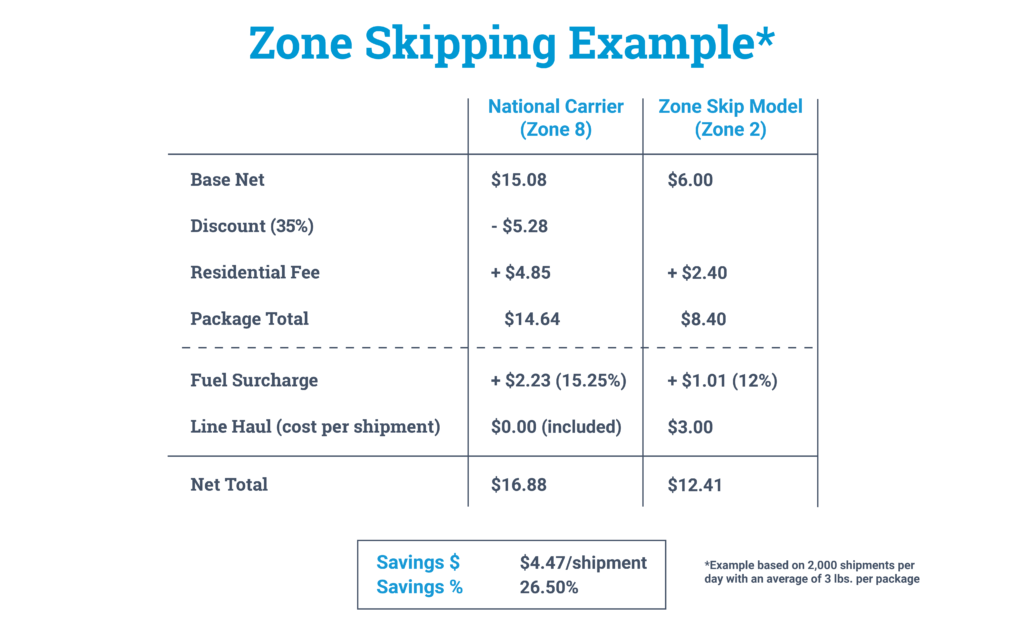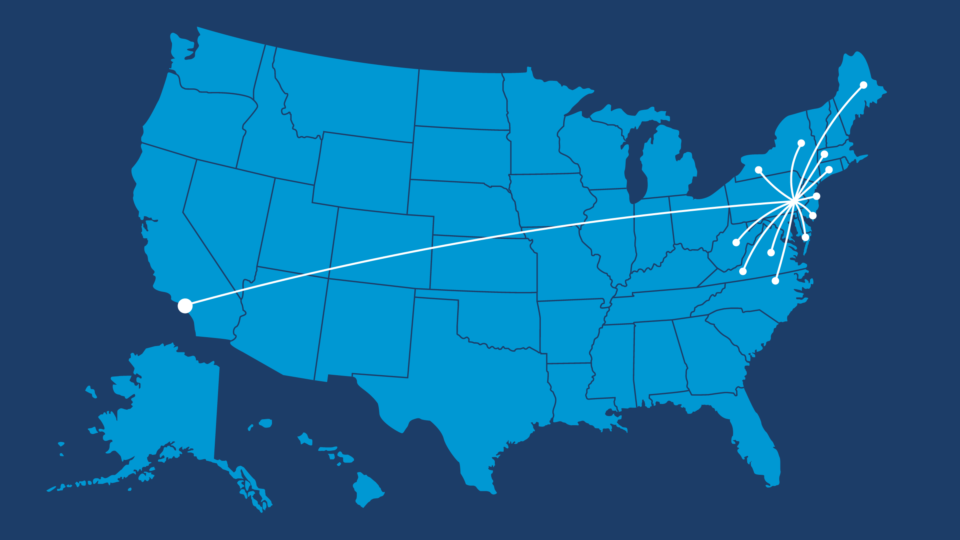Posted On April 4, 2022
More and more companies are getting in the zone—or getting into zone skipping, that is.
As e-commerce has boomed, zone skipping as a method of shipping has become increasingly popular, and the trend is likely to continue. But there’s a science behind the logistics technique, and companies need to have the right resources in place to reap the rewards.
From origin to final destination: how does zone skipping work?
To understand zone skipping, you first have to understand zones and your zone distribution mix.
In the logistics industry, the U.S. is divided into seven geographical regions called zones—starting with number two. Zones are based on the origin zip code, and increase based on the distance between the origin and the destination.
For example, a package ships from Newark, New Jersey to Los Angeles, California would be a Zone 8 shipment. A package shipping from Seattle, Washington to Denver, Colorado is a Zone 5 shipment.
Zone skipping is exactly what it sounds like: skipping zones. A shipper consolidates packages that are all going to the same zone and ships them to that zone via full truckload or less-than-truckload. Typically, the carrier will cross multiple zones before taking them to a parcel carrier’s sorting facility. Once there, the carrier will sort the packages before delivering them to their final destination.
Because it requires a large number of shipments to be effective, zone skipping is ideal for high-volume e-commerce companies with parcel shipments that are below 10 pounds.
For those companies, skipping zones can provide huge advantages.
Zone skipping shipping costs and transit times
One of the biggest benefits of zone skipping are the cost savings. Shipping one consolidated truckload of packages directly to a sorting facility that’s closer to the end customer can greatly reduce the price per package.
Here’s a simplified example: shipping 2,000 packages a day from the west coast to the east coast might cost a company $15.80 per package. With zone skipping, the company could send all 2,000 packages via a truckload carrier to the carrier’s facility. From there, the packages would be delivered via regional / local delivery, with rates and fees totaling $6.24 each. Instead of spending $15.80 in transportation costs shipping individual packages, the company would spend only $12.24 using zone skipping—more than 22% in total savings and the per package price. For a company sending out those shipments every business day, it equals $1.8 million saved per year. (Check out a complete breakdown in the image below.)

On top of lower shipping costs, skipping zones can lead to faster delivery speed and more reliable and consistent transit times. Instead of shipping directly to customers, which often involves stopovers at various facilities and transfers along the way, zone skipping moves products straight to the zone destination, decreasing delays in transit time.
The model also offers more flexibility for parcel shipping. Whereas using a national carrier to deliver parcels requires shippers to adhere to that carrier’s network standards, zone skipping with a regional carrier often allows for more customizable pickup times and accessorial fees.
But zone skipping isn’t just beneficial to shippers—more and more carriers are realizing its appeal. Because fewer hands are touching the shipments in zone skipping, the labor cost is lower and there’s less room for error.
Unfortunately, zone skipping does have some drawbacks. While companies using zone skipping often save money compared to directly shipping to customers, there are often gaps in visibility.
If you’ve ever tried to track an online order, and seen that the package was processed several days ago with no other updates, it’s possible that your order utilized zone skipping. Many packages that skip zones have a 1-3 day in-transit status, where even though the parcels are moving, they aren’t being scanned. It’s not until packages are received by the local hub that updates are available. While this can have a negative effect on the customer experience, ghost codes, or dummy codes that indicate the shipment made it onto a truck and has moved, can solve the issue.
Another downfall: for companies with drastic fluctuation in order volume (with the exception of expected seasonal changes), zone skipping likely isn’t a good solution. If a company needs to send 1,000 shipments one day and only 300 the next, skipping zones probably won’t reduce transportation costs. Those companies are probably better off focusing on distribution and fulfillment, with warehouses in strategic locations where they’ll do the most good.
Incorporating zone skipping into your supply chain
Zone skipping is one of the most cost-effective logistics techniques available to e-commerce companies—but shippers need to have a few capabilities and processes in place to cut down on shipping costs.
- Efficient sorting processes. Freight consolidation requires dock workers to be able to quickly and accurately organize shipments by zip code of the final delivery point.
- Adequate labeling capabilities. Most label printing systems integrate with national carriers, but skipping zones typically utilizes regional carriers. So, a labeling system that works with both is vital. Even better? One that can also produce labels quickly to save time: five seconds per label vs. 15 seconds can make a huge difference on productivity and efficiency.
- A dedicated dock door. A lot of facilities have specific dock doors for specific carriers. Incorporating zone skipping goes much smoother when the warehouse has a dedicated dock with a dedicated conveyor lane. This will also streamline the pickup, too.
- Multi-carrier shipping technology. Yes, even zone skipping can benefit from finding the best carrier. To do that, shippers need a shipping platform that quickly pulls up multiple carrier rates and provides rate shopping for routing decisions.
Perfecting your parcel carrier mix
If you have questions about whether zone skipping can be beneficial for your company, or need help getting started, Flat World can help. Contact us to get started with a free supply chain review.

